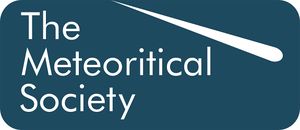Annual meeting of the Meteoritical Society 2010 New-York City
From Wicri Earth
Annual meeting of the Meteoritical Society 2010 New-York City
| |
|---|---|
| Start : | July 26 2010 (iCal) |
| End : | July 30 2010 |
| Homepage : | Website of the meeting |
| City : | New York City |
| Country : | United States |
| Important dates | |
| Notification : | not available |
The 73rd annual meeting of the Meteoritical Society takes place, from 26-30 July 2010, in New York City (United States).
Technical sessions cover a wide range of topics on meteoritics and planetary science. A two-day workshop (Disks, Meteorites, Planetesimals) at the American Museum of Natural History will precede the meeting, and a one-day symposium (Chondrules: their role in early solar system history) will follow.
The program
The complete program[1] is available on the website of the Lunar and Planetary Institute.
- Asteroid Remnants of the Cores of Early Planetesimals, and Where are Their Mantles?
- Toward Understanding Chondrules and Their Formation (Dedicated to Gero Kurat)
- Primitive Achondrites and the Almahata Sitta Fall
- Organic Molecules and Chirality in Extraterrestrial Materials and the Cosmos
- Barringer Invitational Lecture
- Impact Processes and Impact Crater Structures
- Solar Systems Before and During Planet Formation
- Material from Other Stars Preserved in Meteorites and Comets
- Micrometeorites and Interplanetary Dust Particles
- Carbonaceous Chondrites: Chronology and Mineralogy
- Martian Meteorites: Evidence for Fluids, Magmatic Processes, and Impact Processes
- Ordinary and Enstatite Chondrites: Their Origins and Physical Properties
- Plenary Lectures
- Leonard Medal Lecture: Hiroshi Takeda - Mineralogical Comparisons on the Basic Processes of Formation and Evolution of Differentiated Meteorite Parent Bodies and Lunar Highland Crust
- Barringer Medal Lecture: William K. Hartmann - Craters, First Significant Figures, and the Pivotal Year of 4,000,000,000 B.C.E.
- Presidential Address: Hiroko Nagahara - The Fundamental Process of Condensation and Evaporation
- Asteroids: Composition, Evolution, Dynamics and Connection to Meteorites
- First Solar System Solids: Refractory Inclusions in Meteorites
- Extraterrestrial Basalts: Vesta, Angrites and the Moon
- Sample Return Mission Results: Genesis (Solar Wind) and Stardust (Cometary Dust) *Isotopes 1: Light Elements Through Calcium, Mostly Be, B, K and Ca
- Deciphering Secondary Processes on Primitive Asteroids
- Isotopes 2: 26Al/26Mg, Transition Metals, and Beyond
The scientific committee
- Jon M. Friedrich, United States
- Conel M. O’D. Alexander, United States
- Joseph S. Boesenberg, United States
- Harold C. Connolly Jr., United States
- Jeremy S. Delaney, United States
- Alexander Deutch, Germany
- Denton S. Ebel, United States
- Martha S. Gilmore, United States
- Michael Greenberg, United States
- Gregory Herzog, United States
- Mordecai-Mark Mac Low, United States
- Hiroko Nagahara, Japan
- Cherukupalli E. Nehru, United States
- Hanna Nekvasil, United States
- Andrew Rivkin, United States
- Thomas Sharp, United States
- Michael K. Weisberg, United States
The organizing committee
- Denton S. Ebel, United States
- Harold C. Connolly Jr., United States
- Michael K. Weisberg, United States
- Joseph S. Boesenberg, United States
- Jon M. Friedrich, United States
- Michael Greenberg, United States
- Mordecai-Mark Mac Low, United States
- Cherukupalli E. Nehru, United States
- Gretchen Benedix, United Kingdom
- Marc Chaussidon, France
- Joseph I. Goldstein, United States
- Hiroko Nagahara, Japan
- Neil deGrasse Tyson, United States
See also
- The official website of the meeting
Notes
- ↑ The complete program